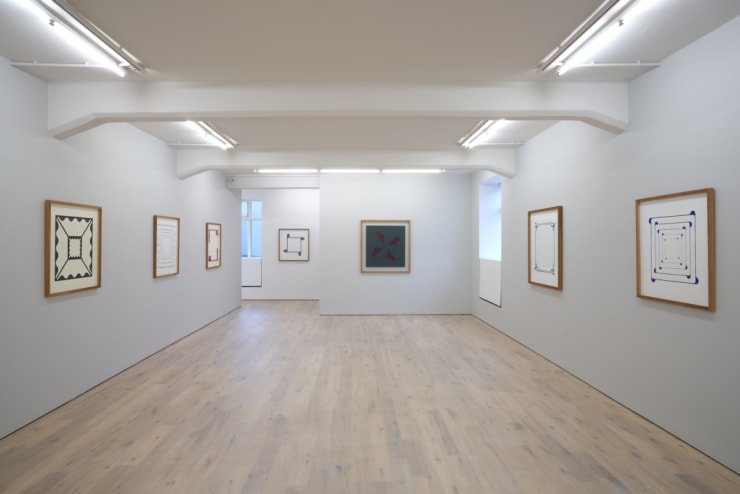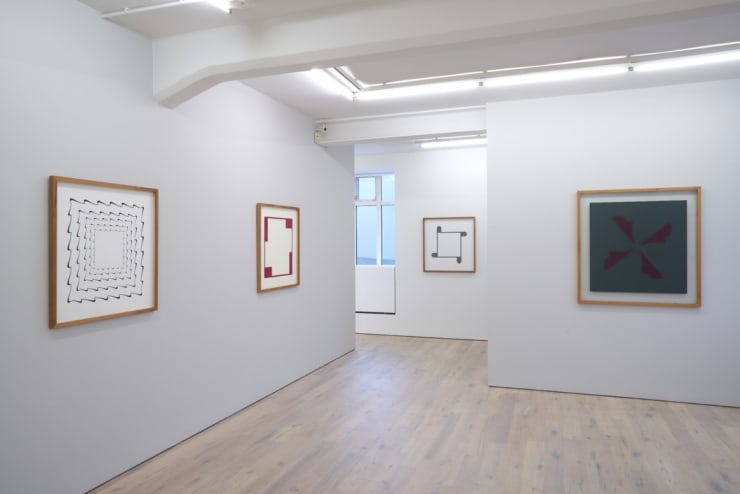Daníel Magnússon: Konstrúktívur vandalismi / Constructive Vandalism - Hverfisgallerí
Konstrúktívur vandalismi
Hringur og þvermál hans eru bundnir innbyrðis hlutfalli sem er torrrætt. Það þýðir að þessi algengustu form sköpunarinnar geta ekki átt samskipti sem vísa í þeirra eigin tilvist. Þannig getur hringurinn ekki lýst þvermáli sínu og þvermálið þekkir ekki hringinn.
Sýningin Konstrúktívur vandalismi er skemmdarverk á fullkominni kennisetningu þeirra Galileo Galilei og Giordano Brunos og upphafning jarðmiðjukenningar Ptólemæosar. Sýningin er jafn rökrétt tilraun mín til að lýsa samkomulagi um heimsmyndina eins og hringsins sem lýsir þvermáli sínu. Vegna þess að list er týranní (alræði?), þá skapa ég þessum heimi öll þau eigindi sem hann þarf til að vera rökréttur á forsendum þeirra sömu takmarkana og þvermálið hefur til að lýsa hringnum sem það spannar.
Þessi heimur bíður ekki eftir né heimtar veður í stíl við væntingar dauðlegra manna. Þeir sem sjá snjókorn hafa séð þau öll. Snjókorn úr heimi Ptólemæosar kallar til þín svo þú megir verða úti eða drukknir í nýfundnu innhafi. Snjókorn úr heimi skáldskaparins boðar feigð fyrir hvert eitt sem nær að falla til jarðar.
Glös sem klingja undir hlátrasköllum í bjartri sumarnóttu, telja snjókorn og tíma í rokgjörnu sigurverki þessa heims. Flyttu okkur úr innhafi í úthaf, kefluð við mastur á gæfulausu rekaldi. Í sögu sem gleymir nafni hetjunnar jafnharðan og hún deyr fyrir óverðugan málstað, í sögu sem ekki fagnar þeim hólpnu, en rifjar upp töpuð stríð með sífelldum skrúðgöngum og hornablæstri.
Heimur þessi er vogskorinn og samsettur úr hvísli. Hann geymir sjávarföllinn innvortis en stormana útvortis. Heimur þessi klárar aldrei setningu nema gleyma henni fyrst. Hann klæðir hégómann göfgi og skapar úr því þegna sína. Hann hlustar á mennina en aðeins á tóna í stafabilum. Hann hlustar á það sem tengir orðin en aldrei á orðin sjálf. Heimurinn er hvíslaður og hreyfingarlaus eins og fljótandi máni í næturtjörn. Sá sem læðist um þennan heim er fangi dvergríkisins, óskir hans rætast ef hann kann að bíða. Þessi heimur er fullkominn í þeirri mótsagnarkenndu vistfræði að tortímast reglubundið. Sól sér aldrei Mánann og hvorugt þekkja þau þvermál sitt, bæði varpa þó skuggum íbúanna í höfuðáttir, sleitulaust og án hvíldar. Ferðalag persónunnar til Bjarmalands ratar til lakariútskota í vogskornum heimi Ptholemiosar. Engu er sóað, gæði og æðstu hnoss eru frátekin fyrir þá sem tilheyra ævintýrum og harmsögum til þess eins að þau glatist í höndum óverðugra. Harmrænn grátur deyr út í klið og raupi þeirra nafnlausu, mannaþefur yfirtekur rósailmi og hetjan snýr aftur frá óglæstum sigrum.
Þessi lýsing er andlegur hluti verkanna, sem flest eru kortagerð.
Verkin eru öll nema tvenn unnin með blýanti og penna á pappír. Þau eru flestöll hugsuð sem kortagerð fyrir hinn miðjusetta heim Ptholemiosar. Tvenn verkanna eru frussprent á bómul, þau eru hugsuð sem undirspil við hin kortin til að gefa þessum heimi heildrænni grunn.
Daníel Magnússon (1958) útskrifaðist úr Myndlista – og handíðaskóla Íslands árið 1987 og vakti þá strax athygli fyrir áhugaverð verk þar sem íslensk menning var oftar en ekki til umfjöllunar. Hann er einkum þekktur fyrir skúlptúra og ljósmyndaverk en hefur jafnframt myndlistinni hannað og smíðað húsgögn. Daníel á að baki annan tug einkasýninga ásamt fjölda samsýninga bæði innanlands og utan.
//
Constructive Vandalism
A circle and its diameter are obscurely related in an irrational ratio. This means that these most common forms of creation can not have relations referring to their own existence. Thus, the circle can not describe its diameter and the diameter is unaware of the circle.
The exhibition Constructive Vandalism is the wrecking of the perfect thesis of Galileo and Bruno and an exaltation of the geocentric theory of Ptolemy. The exhibition is my equally rational attempt to describe a consensus about the cosmology, as the circleʼs attempt to describe its diameter. As art is tyranny, I create for this world all the attributes it needs to be rational on the premise of the same constrictions that the diameter has to describe the circle it spans. This world doesn’t wait for, nor demand, weather in accordance with expectations of mortals. Those who see snowflakes, have seen them all. Snowflakes from the world of Ptolemy beckon you, so that you perish or drown in a newly discovered inland sea. Snowflakes from the world of poetry augur death for each and every one of them that reaches earth.
Clinking glasses and raucous laughter on a summer night measure snowflakes and time in the evanescent clockwork of this world. Move us from the inland sea to the open oceans, tied to the mast of a forlorn wreck. In a story that forgets the heroʼs name as soon as they die after every unworthy deed done, in a story that does not welcome the saved, but reminisces about lost wars with horn-blowing and endless parades.
This world is made of rough coasts and whispers. It harbours the seatides within and the storms on the outside. This world never finishes a sentence except by forgetting it first. It dresses vanity in nobility and creates from that its human subjects. It listens to the spoken word but only to tones in letter spaces. It listens to conjunction between words but never to the words themselves. The world is as whispered and immobile as a floating moon in a pond; he who lurks around in this world is a prisoner of the miniscule state, his wishes come true if he knows how to wait.
This world is perfect in the contradictory ecology of a regular annihilation. The Sun never sees the Moon and neither knows their diameter, although both cast the inhabitantsʼ shadows to the cardinal points, ceaselessly and without respite. The journey of the individual to the promised land finds way to the lesser and rougher shores of Ptolemyʼs cosmos. Nothing is spilt, goods and most precious things are preserved for those who belong to tales of adventure and tragedy, only to perish in the hands of the unworthy. Plaintive crying drowns in the hustle and bustle of the nameless, body odour overwhelms the scent of roses and the hero returns from ignominious victories.
This description is the spiritual aspect of the works, which mainly concern cartography.
All but two are created with pencil and pen on paper. They are mostly intended as cartography for the centralised world of Ptolemy. Two of them are splatter paint on cotton, they serve as accompaniment to the other maps, to lend this world a comprehensive foundation.
Daníel Magnússon (1958) graduated from the School of Visual Arts and Crafts in 1987 and immediately attracted attention for interesting works, where Icelandic culture was often the topic of interest. He is best known for sculptures and photographic works. Daníel has held over a dozen solo exhibitions, along with a number of group exhibitions both in Iceland and abroad.
















